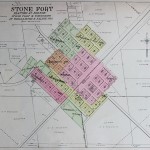Stonefort was first a village about one mile east of the Williamson County line in Saline County, and was named for the ancient stone fort nearby. Construction of this fort is variously attributed to the Spanish soldiers in the sixteenth century, to aboriginal inhabitants preceding the Indians, and even to George Rogers Clark’s company marching to Kaskaskia in 1778. The walls once measured six feet in height, six feet in width, and were arranged in a semi-circle with the southern side an unscalable cliff. If not a defensive fortification, it may well have been a game trap.
This first village of Stonefort became a post office February15, 1858 with Willis Stucker as postmaster. During the late sixties it looked forward to becoming a thriving town when it became a station on the Cairo and Vincennes railroad. It was a pretty place, with a population of 250. There was a brick school, with the Masonic lodge (number 495) above. Its first house was that of Marion Joyner, and his son Frank Joyner (Joiner) was born there.
But the railroad route was changed to avoid the hills, and the village diminished in importance. This natural decline was speeded by the development of the village of Bolton, on the route of the railroad at the county line. Bolton’s town plat was filed October 29, 1872.
Alexander Vickers, one of the owners of Bolton town site, moved a building from Stonefort and opened a general store, the first in the village, on the site later occupied by the brick bank building. The railroad erected a makeshift station. Harper and Norman kept saloon in an ordinary boxed house, that later became the first store of the Pulley brothers, sons of the mill owner. Barton Pulley moved his gristmill from the old town in 1874, but it burned after ten years. Marion Joyner left his family in their home at old Stonefort, and came over to do the building and carpentering required by the new village. Later he built a new home in the new village, and his son became one of the country school teachers before entering the banking business.
William H. Ridgway built the first new store, where his two sons, William J. and John L. Ridgway joined him in business until they both had stores of their own. After ten years the older son moved to his farm in the north part of the township. John L. Ridgway built a roller mill when the new method of making flour began to be used.
A bank was opened, with Lucas Joiner as cashier and Robert M. Hundley of Marion as the financial backer. Mr. Joiner married Miss Jane, a daughter of Wesley Trammell of Bolton.
The post office at old Stonefort was moved over to the new town, and retained the same name. Among the early postmasters were Alexander Vickers, Calvin S. Blackman, and John L. Ridgway. The railroad also called its station Stonefort.
But Williamson county men, especially J. Van Trammell, insisted on the name Bolton. Mr. Trammell was son and grandson of Bolton postmasters, he lived in Bolton, and he continued to make deeds to his lands in the original town plat and in his many additions, all specifying land in Bolton. As the village of Bolton, with 350 residents, the place was incorporated June 21, 1875. This confusion of post office and railroad officially named Stonefort but located in the village of Bolton, continued until 1936 when the village council determined that Stonefort is the official name.
The railroad, the reason for Stonefort’s origin, was reorganized as the Cairo, Vincennes and Chicago railroad company, which leased the property to the Wabash. After a number of years the line came into the hands of the Big Four, or the Cleveland, Cincinnati, Chicago, and St. Louis railroad. In 1939, it was operated as part of the New York Central lines.
See also, Bolton History
Note: After the last move, the village of Stonefort fell on the Saline County side of the county line where it remains today.
(Extracted from Pioneer Folks and Places, Barbara Barr Hubbs, 1939, on sale at the Williamson County Museum)

